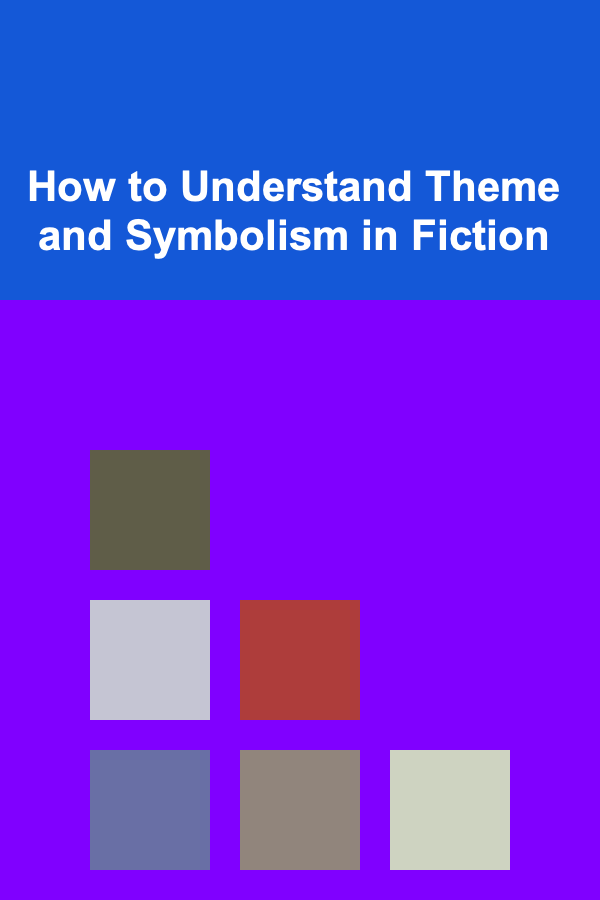
How to Understand Theme and Symbolism in Fiction
ebook include PDF & Audio bundle (Micro Guide)
$12.99$10.99
Limited Time Offer! Order within the next:

Fiction has always been a powerful medium for communicating ideas, emotions, and experiences. Writers often use various literary devices to give depth to their stories, two of the most important being theme and symbolism. Understanding these elements not only enhances the enjoyment of reading but also allows readers to delve deeper into the messages and ideas that the author seeks to convey.
This article aims to explain the concepts of theme and symbolism in fiction, how they work together, and how to identify and interpret them effectively. We will explore their definitions, examine how they function within different kinds of narratives, and discuss practical strategies for readers to better understand these fundamental components of storytelling.
What is Theme?
Defining Theme
In literature, the theme refers to the central idea or underlying message of a story. It is not necessarily a topic but the larger concept that the story addresses. Themes can emerge from the plot, characters, setting, and even the style of the writing. They are often abstract and can cover universal human experiences such as love, death, conflict, freedom, or identity.
For instance, in George Orwell's 1984 , the theme revolves around the dangers of totalitarianism and the loss of personal freedoms. In Harper Lee's To Kill a Mockingbird, themes of racism, social justice, and moral growth are explored.
Types of Themes
Themes in fiction can be broad or specific, and they often come in pairs or groups, offering a layered narrative. Some common types of themes include:
- Universal Themes: These are themes that have a broad human appeal. They deal with fundamental aspects of human existence such as love, power, betrayal, or mortality.
- Moral Themes: Many stories explore questions of right and wrong, justice and revenge, or good versus evil.
- Social or Political Themes: These themes are concerned with the way societies are structured, exploring issues like class, race, and inequality, often with a critique of social systems.
- Psychological Themes: Some stories delve into the human psyche, exploring themes like identity, guilt, consciousness, or mental illness.
- Existential Themes: These focus on the meaning of life, free will, and existential crises.
How to Identify a Theme
Understanding a story's theme requires careful reading and analysis. Here are some steps you can take to identify the theme in a work of fiction:
- Look at the Big Picture: After reading the story, think about the major events and turning points. What are the key ideas that seem to emerge from the character's actions, the plot's resolution, and the conflicts?
- Character Development: Often, the theme is reflected in the growth or change of the protagonist. What lessons does the character learn? How do they evolve throughout the story? This is a significant clue to the central theme.
- Author's Tone and Message: The way a writer presents their narrative, the tone they use, and the style of their writing often reveal a lot about the theme. If a story is written in a tragic tone, it may be exploring themes of loss or inevitability. A hopeful tone, on the other hand, could indicate a theme of redemption or personal growth.
- Repetition and Motifs: Pay attention to recurring elements or ideas in the story. These motifs can often point to the theme. If certain ideas or concepts reappear, they are likely reinforcing the theme the author wants to emphasize.
What is Symbolism?
Defining Symbolism
Symbolism in fiction refers to the use of objects, characters, settings, or events that represent something beyond their literal meaning. Symbols can carry deep meanings, often relating to the story's themes, and are often open to multiple interpretations. A symbol is something that stands for something else, evoking ideas or emotions in a way that goes beyond its concrete presence in the narrative.
For example, in F. Scott Fitzgerald's The Great Gatsby , the green light at the end of Daisy's dock is a symbol of Gatsby's unattainable dreams and his longing for a past that can never be recreated. Similarly, the conch shell in Lord of the Flies symbolizes civilization and order amidst chaos.
Types of Symbols
Symbols can take many forms in fiction, including:
- Objects : Inanimate things that have a deeper meaning, such as the aforementioned green light in The Great Gatsby , or the ring in The Lord of the Rings, which symbolizes power and corruption.
- Characters : Certain characters can themselves be symbols. For example, in The Catcher in the Rye, Holden Caulfield represents the struggle between innocence and the adult world.
- Settings : Locations and environments can also carry symbolic weight. In The Scarlet Letter, the prison represents punishment and isolation, while the forest symbolizes freedom and sin.
- Events : Key events in a story can symbolize larger ideas. For example, the storm in The Tempest symbolizes chaos, while the act of killing a character in a story might symbolize the loss of innocence or a turning point in the narrative.
How to Identify Symbols
To identify symbolism in a work of fiction, consider the following approaches:
- Look for Repetition: Symbols often appear repeatedly throughout the text, subtly reinforcing their significance. If a specific object, place, or event keeps coming up, it may symbolize a central idea or theme.
- Contextual Meaning: Consider the context in which the symbol appears. Does the object or event change in meaning depending on the situation or the character's development? Often, symbolism is tied to the emotional and psychological journeys of the characters.
- Consider Cultural and Historical Contexts: Symbols may have meanings derived from cultural or historical contexts. A particular object or event may carry significant symbolism that resonates with the time period or societal themes in which the story is set.
- Think about the Author's Intent: Why would the author choose to imbue certain things with symbolic meaning? If a character is associated with a specific color, animal, or object, ask yourself what that association might represent in the larger scope of the story's themes.
How Theme and Symbolism Interact
Themes and symbolism often work hand in hand. While themes are the larger ideas and messages a story seeks to communicate, symbolism helps to express and reinforce those ideas. A well-constructed narrative weaves together both elements, with symbols providing a concrete means of representing abstract themes.
For instance, in William Golding's Lord of the Flies, the theme of the inherent violence and savagery of human nature is symbolized through the conch, which represents order and civilization. As the boys' descent into barbarism accelerates, the conch's destruction signals the complete collapse of societal structures and the triumph of primal instincts.
Similarly, in John Steinbeck's The Grapes of Wrath, the theme of economic hardship and injustice is symbolized through the Joad family's journey westward, as their struggles mirror the suffering of countless dispossessed individuals during the Great Depression.
Practical Strategies for Understanding Theme and Symbolism
While understanding theme and symbolism may seem complex, there are several practical strategies that can enhance your ability to analyze them effectively:
- Read Actively: Don't simply skim through the text. Pay close attention to details, the structure of the narrative, and the development of characters. This will help you recognize recurring symbols and ideas.
- Reflect on the Emotional Tone: How does the text make you feel? The emotions evoked by the story can often help you identify underlying themes and symbols.
- Revisit Key Passages: Often, understanding a story's theme or symbolism requires revisiting key moments or passages. A deeper understanding of these sections may reveal hidden meanings that weren't apparent in your first read.
- Discuss the Story: Talking with others about the story can provide new insights. Different readers may interpret symbols and themes in various ways, and discussing these ideas can lead to a richer understanding of the text.
- Study Literary Criticism: Reading academic analyses or literary critiques of the work can expose you to new interpretations of its themes and symbols. Scholars often uncover deeper layers of meaning that are not immediately apparent to casual readers.
Conclusion
In fiction, theme and symbolism are indispensable tools for exploring deeper meanings and conveying complex ideas. While the theme is the central message or idea of the story, symbolism provides the concrete images, objects, or events that represent those abstract concepts. Together, they enrich the narrative, offering readers a more profound and multifaceted experience. By actively engaging with these elements and using the strategies outlined in this article, readers can unlock the full potential of a story, finding new interpretations and insights that go beyond the surface plot. Through this process, fiction becomes not only an entertaining escape but also a means to explore the complexities of life, culture, and the human experience.

How to Budget for Holiday Spending
Read More
How to Research Locations for Potential Treasure Finds
Read More
How To Understand the Dark Web (and How to Avoid It)
Read More
How to Use Lighting to Highlight Architectural Features in Your Home
Read More
Cashier Skills: How to Build a Resume That Stands Out
Read More
10 Tips for Leveraging CRM Data for Predictive Analytics
Read MoreOther Products

How to Budget for Holiday Spending
Read More
How to Research Locations for Potential Treasure Finds
Read More
How To Understand the Dark Web (and How to Avoid It)
Read More
How to Use Lighting to Highlight Architectural Features in Your Home
Read More
Cashier Skills: How to Build a Resume That Stands Out
Read More